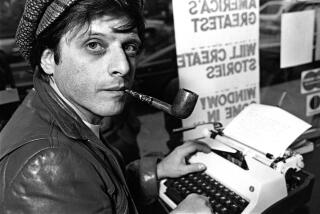Allen Parkinson, 83; Sleep-Eze Mogul Built Movieland Wax Museum
- Share via
Allen Parkinson, a star-struck entrepreneur who made a fortune with his over-the-counter sleep aid and then built a world-class wax museum dedicated to Hollywood legends, has died. He was 83.
Parkinson, the creator of Sleep-Eze and the original owner of Movieland Wax Museum in Buena Park, died of natural causes Aug. 19 at his home in Warwick, R.I.
With a showman’s flair, Parkinson opened Movieland Wax Museum in May 1962 with all the hoopla of a Hollywood premiere: searchlights, bleachers holding thousands of fans and the arrival of stars in long black limousines.
No less than Mary Pickford cut the ceremonial ribbon at the Beach Boulevard museum, which included a wax likeness of America’s Sweetheart and dozens of other film greats ranging from Rudolph Valentino to James Dean.
At its peak in the 1960s, Movieland drew as many as 1.2 million visitors a year, and Hollywood superstars considered it an honor to be selected for enshrinement in wax.
With the addition of each new star’s wax likeness to the museum, Parkinson would send a gold Rolls-Royce to bring the honored celebrity to Buena Park in style.
“He was a man with tremendous imagination,” recalled Beebe Kline, a former vice president of the publicity firm Rogers & Cowan, who represented Sophia Loren in 1962 when she was included in the museum in a scene from “Two Women.”
Kline recalled that Parkinson flew to Loren’s villa in Italy, where the actress presented him with the dress she had worn in the film, for which she won an Oscar.
“Whenever he did anything, he always met with the people,” said Kline. “They had to have pictures, all of the exact measurements and everything so they could duplicate them.”
Parkinson followed up Movieland with the nearby Japanese Village and Deer Park, and the museum-adjoining Palace of Living Art, for which he hired sculptors to re-create classic paintings in three-dimensional wax figures.
“He was definitely a dreamer,” Emily Hamilton, Parkinson’s granddaughter, said Friday. “He just loved thinking of new ideas. He’d sit at the dinner table and say, ‘What do you think of this idea?’ And it was always the idea rather than the money [that interested him]. It was more just thinking of different fun things.”
For someone who “couldn’t do math--he was a brilliant man, but he had no concept of math at all,” Hamilton said with a laugh, “it was amazing he made money.”
Born on a farm in Rexburg, Idaho, Parkinson grew up in Salt Lake City, where he fell in love with the movies.
“For most of us in those Depression years,” he once said, “movies were the windows on the world.”
After various jobs such as selling Indian jewelry in several Western states, he joined the merchant marine in 1939. After World War II, he quickly worked his way up from a salesman to international sales manager for Mercury Records.
He was working as a salesman for a wine company in 1948 when he noticed an ad in a Canadian newspaper for a sleep aid called Persomnia.
Plagued by insomnia himself, Parkinson thought the idea of a sleep aid was good but the name was terrible.
After coming up with what he felt was a better name--Sleep-Eze--he engaged chemists in a product development company.
Fellow insomniacs turned non-barbiturate Sleep-Eze into a bestseller that gave Parkinson a million-dollar payday when he sold it in 1959.
Inspired by a 1958 visit to London with his daughter where he saw a block-long line of people waiting to view the historical wax figures in Madame Tussaud’s wax museum, Parkinson figured people would line up to see wax versions of Hollywood stars.
He launched a worldwide search for the world’s best sculptors and sank all of his Sleep-Eze fortune into buying land near Knott’s Berry Farm and building a modern, white-columned museum building furnished with crystal chandeliers.
When he saw Hollywood’s biggest stars disgorging from their limos the night of the $1.5-million museum’s opening, he recalled a few years later, “I couldn’t believe my eyes. I was still the kid with the popcorn in the balcony.”
Movieland Wax Museum Vice President Rodney Fong, whose family bought the business in 1980, praised Parkinson “for the level of passion he had for the movie industry in creating sets and wax figures” at the museum
The sets, Fong said, “were really three-dimensional. You don’t walk past these sets, you actually walk into many of them. It’s a huge accomplishment, especially if you take into consideration that a wax museum is a static display.
“You can only create that through passion. Not only the wax museum but his other projects were a passion.”
Parkinson sold Movieland and the other two attractions to Six Flags for $10 million in 1970.
“He got bored,” said his granddaughter. “He wanted to do something else.”
He sold his home in Costa Mesa and bought a 40,000-acre ranch in Scottsdale, Ariz., where he raised horses and bred cattle.
But after about eight years on the ranch, his granddaughter said, “he lost almost everything” in the stock market downturn and wound up declaring bankruptcy.
Parkinson, who was ill with cancer and heart problems in the last year, remained a dreamer until the end, his granddaughter said.
“Even the last day of his life, he was like, ‘What do you think of
In addition to his granddaughter, Parkinson is survived by his daughter, Patricia Noel of Alamo, Calif., near San Francisco; two other grandchildren; and a great-grandson.
More to Read
The biggest entertainment stories
Get our big stories about Hollywood, film, television, music, arts, culture and more right in your inbox as soon as they publish.
You may occasionally receive promotional content from the Los Angeles Times.










